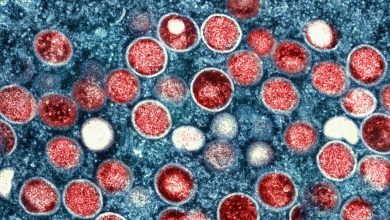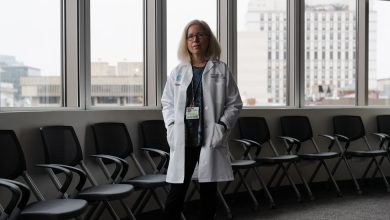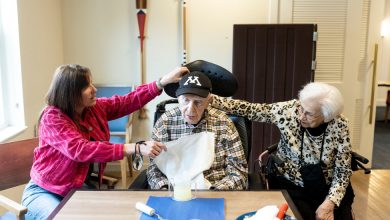C.D.C. Shortens Covid Isolation Period for Health Care Workers

With rising concern over hospital staffing shortages as Omicron cases rapidly spread, the Centers for Disease Control and Prevention on Thursday shortened isolation periods for health care workers who contract Covid-19.
The agency recommended that health care workers who are asymptomatic return to work after seven days and a negative test, adding that “isolation time can be cut further if there are staffing shortages.”
The agency also said that those workers who had received all recommended vaccine doses, including boosters, do not need to quarantine at home following high-risk exposures.
The new guidelines apply to all health care facilities that are directly involved in patient care. That would include hospitals, nursing homes, dental offices and other medical sites.
While infections with Omicron more often lead to milder illnesses, the variant is highly transmissible and hospitals have been bracing for an influx of vulnerable Americans.
Many major hospital systems had already been forced to move ahead on their own in recent days, creating a patchwork of guidelines regarding infected workers in anticipation of a winter surge.
The shortest such policy for returning to work — five days, with some other preconditions — is half the 10-day standard set earlier by the C.D.C. Other hospitals have settled on seven days as a safe window for infected staff members to return to work.
The agency’s new recommendations do not apply to the public. Early in the pandemic, the C.D.C. had set a 14-day isolation period for infected Americans, to lower the risk of contagion, but then winnowed that back as more research confirmed that a typical patient would be infectious for a shorter amount of time.
Criticized for shifting guidance and mixed messaging, the C.D.C. decision to recommend the changes only for health care workers is likely to add to the confusion among Americans, especially since Britain issued a broad recommendation for shortened isolation on Wednesday that applies to everyone.
Britain’s Health Security Agency cut the period for all infected individuals to seven days from 10 days, if they have twice tested negative with rapid antigen tests.
Some medical experts pointed to limited evidence regarding when a person infected with the Omicron variant might no longer be contagious. But other researchers have been urging shorter periods and said that the C.D.C. revisions were overdue.
“They are consistently behind in updating recommendations that are needed now, especially as we face the daunting prospect of a sudden surge in cases,” said Angela Rasmussen, a virologist at the Vaccine and Infectious Disease Organization at the University of Saskatchewan in Canada.
Dr. Ashish Jha, dean of the Brown University School of Public Health, said it would make sense to shorten isolation times for the public, as well — especially for those who are vaccinated.
“Given that a large proportion of health care workers, like other Americans, are going to get infected, finding a shorter period of time for isolation is critical,” Dr. Jha said. “I think we have reasonably good evidence with Delta that vaccinated people clear the virus far more quickly. There is no reason to believe that wouldn’t be true for Omicron.”
Hospital administrators have stressed that the new changes allowing employees to resume work sooner would not put patients at risk.
Given that health care workers are tested frequently, are largely vaccinated, and must be masked, “the chances of causing a significant amount of infections seem very low” if isolation periods are shortened, said Dr. Bob Wachter, chairman of the department of medicine at the University of California, San Francisco.
“The consequences of keeping them out of the work force are massive when you think about the impact on health,” he added. U.C.S.F. also is weighing whether to reduce the isolation period to five days for workers: “I don’t know if five days saves us, but it’s better than seven and better than 10.”
Dr. Jha stressed, though, that more research is needed to definitively answer questions regarding how long a person with an Omicron infection may remain infectious. The variant is far more contagious than previous versions of the coronavirus.
The pandemic has exacerbated labor shortages that plague both hospitals and nursing homes: Nurses, aides and other workers have suffered extensive burnout and many have left the field for more lucrative work. Just this week, President Biden said that 1,000 military medical professionals would be deployed to help hospitals, and the National Guard is already working in some nursing homes and hospitals to address understaffing in several states.
Getting medical staff back to work sooner is the aim of several policy changes at hospitals that are reporting higher caseloads. Along with a shorter time frame for isolation, the policies include requirements regarding testing, vaccination status and symptoms.
Hospitals welcomed the revised guidelines. “Today’s announcement from the C.D.C. will allow health care workers to safely return to caring for patients sooner, which will help to alleviate the severe work force shortage crisis facing hospitals across the country,” said Nancy Foster, vice president of quality and patient safety policy for the American Hospital Association.
In New York State, which has reported a seven-day average of more than 4,600 hospitalizations as Omicron cases soar, major hospitals recently changed isolation protocols for vaccinated employees.
N.Y.U. Langone shortened its return-to-work policy to five days after a worker receives a positive test, or three days after a fever has subsided, whichever is longer. NewYork-Presbyterian reduced its isolation period to seven days. On Thursday, the Mount Sinai Health System also shifted to seven days from 10.
“Guided by the latest science, our current protocols allow fully vaccinated employees to return to work after seven days,” said Joy Valenzuela, a spokesman for NewYork-Presbyterian.
The Coronavirus Pandemic: Key Things to Know
The holiday season. With planned end of the year gatherings, the new Covid surge is prompting worries and cancellations. The Times asked experts to share some holiday guidance, as well as some tips on using at-home virus tests (if you can find any). Here is what to do if you test positive for the coronavirus.
The Omicron variant. The highly transmissible Covid version appears to be less severe than previous variants, according to new studies. Research also suggests many non-mRNA vaccines offer almost no defense against infection, though the Pfizer and Moderna boosters, which are mRNA-based, most likely provide strong protection.
New treatments. The Food and Drug Administration authorized in short succession the first two pill treatments for Covid-19 from Pfizer and Merck. The new drugs, which can be taken at home with a doctor’s prescription, will be available to some Covid patients who are at higher risk of becoming severely ill.
Biden’s new plan. President Biden announced new steps to confront the surge in Covid cases, including setting up new testing sites and buying 500 million rapid tests to distribute free to the public. But experts warned the measures would not stop an Omicron surge, and it could be weeks until enough tests are available.
Around the world. After infections skyrocketed to record levels in South Africa, new cases have started falling, suggesting its Omicron wave may have peaked. In Europe, the Netherlands, Britain and Denmark adopted tough restrictions, while France, Spain and Italy are taking a more measured approach.
Northwell Health’s guidelines now allow fully vaccinated workers to return to work eight days after a positive test or after symptom onset, if their symptoms are improving and they have not had a fever for 24 hours.
Many hospitals are already overburdened, especially with patients who remain unvaccinated and those who have delayed necessary care during the pandemic.
“Speaking on behalf of Rhode Island, we are already in a disaster level of care,” said Dr. Megan Ranney, an emergency physician and academic dean at Brown University’s School of Public Health.
“We have no beds in the E.R. We have no I.C.U. beds that are staffed. We are making decisions around treatment and triage that are demoralizing and beyond what I would have thought we would be doing at this point in the pandemic.”
The research on how long people remain infectious with Omicron is so far thin. A study in Norway looking at a large cluster of individuals who were infected with the variant at a Christmas party in Oslo suggested that the incubation period was around three days, shorter than for Delta.
The study authors sent out a questionnaire this week to find out how long those infected stayed symptomatic, said Frode Forland, specialist director for infectious diseases at the Norwegian Institute of Public Health.
C.D.C. guidance says that vaccinated individuals who get infected with Delta are likely to be infectious for less time than unvaccinated people.
Ann Marie Pettis, the president of the Association for Professionals in Infection Control and Epidemiology, acknowledged that decisions were being made on limited data. Federal officials, she said, had to weigh the risk of letting people go back to work too soon against the potentially greater risk of not having enough health care workers to care for patients.
“The staffing shortage is a horrible situation right now, pretty much across the board,” she said. Hospitals that moved ahead with shortened isolation periods are likely concerned that with large numbers of staff getting infected and staying out for 10 days.
“They just can’t care for the patients they are trying to see,” Ms. Pettis said.
While the situation is not nearly as dire as at the start of the pandemic, she said, the choices now recalled a time when federal officials, faced with a severe shortage of personal protective equipment, relaxed the guidance around face coverings.
Deciding how to best protect workers and patients is challenging, she said: “I don’t envy the C.D.C. making the call.”
Others expressed a bit of frustration with the situation medical and health professions find themselves in at this stage of the pandemic. “The fact we have to discuss this in advance of clarifying guidance from public health authorities is an indication of the impact that the Omicron variant’s spread will have on an already overstressed health care system,” said Dr. Daniel Diekema, a physician and epidemiologist at the University of Iowa Carver College of Medicine.
Some health care workers themselves say they are concerned that shortened isolation periods could endanger both staff and patients. “That would be absolutely unconscionable,” said Jane Thomason, the lead industrial hygienist for National Nurses United, a large union that has been outspoken about the need to protect their members.
Dr. Ranney warned that the new protocols must be followed carefully: “This should not be the equivalent of, ‘I don’t care if you have an N95, go ahead and take care of patients anyways’,” she said, referring to protective masks. “That’s not fair to the workers, and that’s not fair to the patients.”





